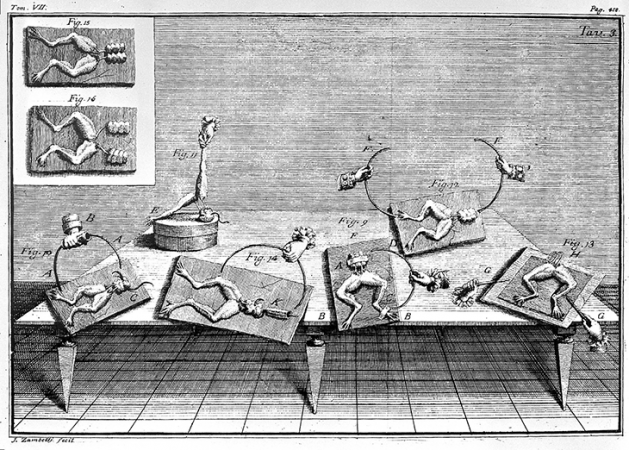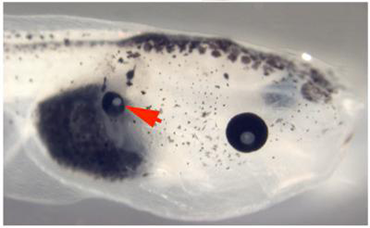Could Wednesday Addams really jolt a frog back to life?
Electricity is powerful, but not in the way seen in The Addams Family

Instead of dissecting a dead frog in biology class, Wednesday Addams of The Addams Family movie resurrects the amphibian. That can’t happen in real life. But the scene shares a lot with science of the past. These days, researchers are still learning about the body electric.
© 2019 Metro-Goldwyn-Mayer Pictures Inc.
It’s frog dissection day in biology class in the new film The Addams Family. Wednesday Addams thinks she knows what to do. First, she leaps on the table. Then, raising her hands to the sky, she shouts, “Give my creature life!” A device that pulses with electricity now shocks a dead frog waiting to be cut open by the kids’ scalpels. The electricity then bounces from one frog to another. Suddenly, frogs are hopping everywhere — a bit groggy at first, but apparently as alive as ever.
This wild scene isn’t one you’ll be able to recreate on dissection day in your own science class. Electricity can’t jolt the dead back to life. Still, this scene has a lot in common with experiments that happened hundreds of years ago. Back then, scientists were learning how electricity kicks muscles into motion.
Today’s researchers know that electricity can do a lot of amazing things — including help shape the body in the first place.
Muscle powerhouse
Skeletal muscles help animals move and breathe. These muscles move because of tension in their fibers. This is called “contraction.” Muscle contractions are triggered by signals that start in the brain. The electrical signals travel down the spinal cord and to the nerves that reach into muscle.
But electric impulses also can come from outside the body. “If you’ve ever shocked yourself on something, your muscles contracted,” explains Melissa Bates. A physiologist at the University of Iowa in Iowa City, she studies how bodies work. Bates focuses on the diaphragm. That’s a muscle that helps mammals breathe.
Shocking a dead frog might make its muscles twitch and get its legs to wiggle. Still, this animal couldn’t hop away, Bates points out. That’s because leg muscles can’t make their own electrical signals.
As soon as a frog hopped away from the source of electricity, the game would be up, she says. “It would fall down and be limp and not able to move.” (This applies to the muscles in a hand, too. And that has left Bates wondering how Thing — a hand without a body — can move at all.)
There are some muscles in the body that can power themselves. Involuntary muscles, such as the heart and muscles that move food through the intestines, supply their own electric impulses. In an animal that has recently died, these muscles continue to function for a while. They can keep contracting for minutes to upwards of an hour, Bates says. But that won’t help the frog make a getaway.
It is possible to use electricity to revive people when they are having a heart attack. For this, people use machines called defibrillators (De-FIB-rill-ay-tors). This isn’t reanimating the dead, though. Defibrillators only work “in something that appears lifeless but still has some of its own electrical potential to reboot that system,” Bates explains. Electricity helps get heartbeats back to a regular rhythm. But this won’t work if the heart has stopped beating entirely (which happens when it has lost its ability to make electrical impulses).
The frogs from biology lab have probably been dead for quite a while and preserved with chemicals. They couldn’t be revived with a defibrillator because they wouldn’t have any heart electrical activity left to jump start.
Twitch, twitch
Wednesday Addams’ froggy antics, while impossible, call to mind experiments that scientists did in the late 1700s. “That was the first hint that electricity is an important part of our body,” says Bates. Back then, people were just starting to see what electricity could do. Some shocked dead animals to figure out how electricity made muscles move.
The most famous of these experimenters was Luigi Galvani. He worked as a doctor and physicist in Italy.
Galvani mostly worked with dead frogs, or rather their bottom halves. He would slice open the frog to reveal the nerves that ran from the spinal cord to a leg. Then, to study how a frog’s muscles respond to electricity, Galvani would wire up the frog’s leg under different conditions.

By this time, scientists already knew that an electric shock would make muscles twitch. But Galvani had questions about how and why that happened. For example, he wondered if lightning would do the same thing as the electricity made by his machine. So he hooked up one animal to a wire that snaked outside to a thunderstorm. He then watched those frog legs dance when they were jolted by lightning — just as they did with his machine’s electricity.
Galvani also noticed that when a wire connected a leg muscle to a nerve, the muscle contracted. This led him to hypothesize an “animal electricity” inside creatures. Galvani’s research inspired many scientists and created a new field of study that investigated electricity in the body.
Such work also inspired fiction. “There is an imagination that followed Galvani’s experiments,” says Marco Piccolino at the University of Ferrara. He’s neurologist, a scientist who studies the body’s nervous system. Piccolino, based out of Pisa, Italy, is also a science historian. Galvani’s experiments and those of the scientists that followed him helped inspire Mary Shelley’s novel Frankenstein, Piccolino says. In her classic book, a fictional scientist gives life to a human-like creature.
Sparking life
Nobody has figured out yet how to use electricity to make the dead come back to life. But some researchers have figured out how to hack cells’ electric signals to change how animals develop.
Michael Levin works at Tufts University in Boston, Mass, and at the Wyss Institute of Harvard University in Cambridge, Mass. As a developmental biophysicist, he studies the physics of how bodies develop.
“All of the tissue in your body is communicating electrically,” he notes. By eavesdropping on those conversations, scientists can crack the cells’ code. They also can play back the electrical messages in other ways to alter the body’s development, he says.

Cells in the body have an electric potential (a difference in charge) across their membranes. This potential comes from how charged ions are arranged inside and outside of cells. Researchers can mess with this using chemicals that change where the ions can go.
Manipulating these signals has allowed Levin’s team to tell a frog tadpole to grow an eye in its gut. They also have gotten brain tissue to grow elsewhere in a frog’s body. They’ve even been able to tell nerves how to connect to a newly attached eye.
Everyone thinks genes determine how an animal develops. But “that’s only half the story,” Levin says.
Bioelectricity could hold the power to fix birth defects, regrow organs or reprogram cancerous cells. Levin and his colleagues have already fixed birth defects in tadpoles. And they picture a day when electricity could be used similarly in medicine.
This is far from Wednesday Addams and her reanimated frogs — but so much better.







